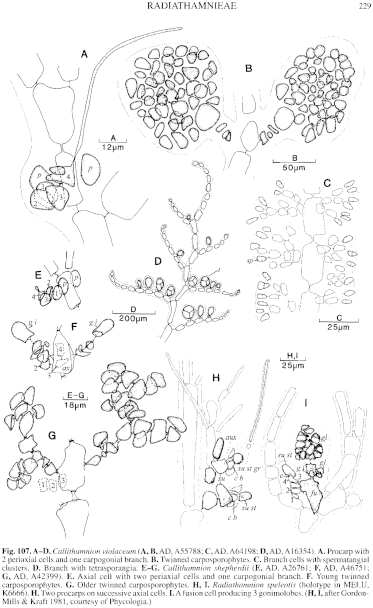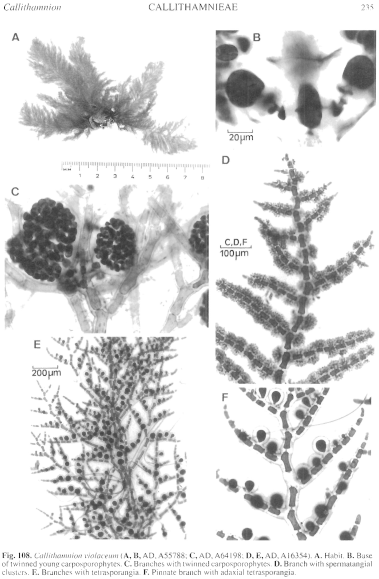|
|
|
|
|
|||||||||||
|
Electronic Flora of South Australia Species Fact Sheet
Phylum Rhodophyta – Order Ceramiales – Family Ceramiaceae – Tribe Callithamnieae
Selected citations: J. Agardh 1876: 47. Sonder 1881: 10.
Synonyms
Spongoclonium violaceum (Harvey) De Toni 1903: 1361. Lucas 1909: 50; 1927: 468, pl. 34 fig. 2; 1929a: 24.
Callithamnion paradoxum Harvey 1859b: 337; 1863, synop.: li. J. Agardh 1876: 49. Lucas 1929a: 24. Sonder 1881: 10.
Spongoclonium paradoxum (Harvey) De Toni 1903: 1363. Lucas 1909: 50; 1927: 466, pl. 32; 1929a: 24..
? Spongoclonium scoparium J. Agardh 1894a: 117. De Toni 1903: 1363. Lucas 1909: 50; 1927: 468.
Thallus (Fig. 108A) erect and spreading, grey-red to red-brown or red-violet, 2–6 cm high, densely tufted and often even-topped, with main axes bearing laterals for several orders. Branches more or less alternately distichous (Fig. 108F), ecorticate, with a prominent gelatinous sheath, lower filaments and pinnules usually unbranched; lower axes with loose descending rhizoids. Attachment by loose rhizoids; epilithic or on small mussels. Structure. Lower axes 70–120 (–300) µm in diameter, cells L/D (2–) 3–6, lateral branchlets alternately distichous with lower cells 30–55 µm in diameter and L/D (1.5–) 2–4, tapering to 25–35 µm in diameter and L/D 1–3 at 2–3 cells below their apices, ends of apical cells rounded. Cells uninucleate; rhodoplasts ovoid to ribbon-like.
Reproduction: Gametophytes dioecious. Procarps (Fig. 107A) borne on axial cells of the branches, with two periaxial cells one of which (the supporting cell) bears the 4-celled carpogonial branch; post-fertilization each periaxial cell cuts off an auxiliary cell (Fig. 108B) and two rounded lobes (Figs 107B, 108C) (150–350 (–450) µm across) of carposporangia 25–35 pin in diameter. Spermatangia (Figs 106C, 107D) are borne in dense clusters on the upper side of (spreading all around) cells of the last two orders of the branchlets, each cluster with a single basal cell bearing 2–3 orders of smaller cells and terminal ovoid spermatangia 1.5–4 µm in diameter.
Tetrasporangia (Figs 107D, 108E, F) sessile and adaxial on lower cells of the ultimate branchlets, scattered or on each cell, subspherical to ovoid, 50–75 µm in diameter, tetrahedrally divided.
Type from Georgetown, Tas. (Harvey, Alg. Aust. Exsicc. 517); lectotype in Herb. Harvey, TCD.
Selected specimens: Robe, S. Aust., upper sublittoral pool in bay (Womersley, 5.xii.1995; AD, A64769). Warrnambool, Vic., drift (Kraft, 30.xii.1989; MELU, A38225/6 and AD, A67831). The Rip, Port Phillip Heads, Vic., 16–20 m deep (Kraft, Saunders & Strachan, 10.v.1995; MELU). Rocky Cape, NW Tas., low eulittoral pools (Womersley, 17.x.1982; AD, A55609). Bridport, Tas., low eulittoral pool (Womersley, 13.x.1994; AD, A64198). Bicheno, Tas., lower eulittoral (Womersley, 19.i.1949; AD, A10215). Tesselated Pavements, Eaglehawk Neck, Tas., lower eulittoral (Womersley, 20.ii.1986; AD, A65939). Taroona, Tas., mid eulittoral (Womersley, 13.i.1949; AD, A10156). Stewarts Bay, Port Arthur, Tas., mid eulittoral (Cribb 149.11, 21.vi.1951; AD, A16354) and (Womersley, 30.x.1982; AD, A55788).
Distribution: Robe, S. Aust., to Western Port, Vic. (Wilson), and around Tasmania.
Taxonomic notes: The type specimen of Callithamnion paradoxum from Browns R., Tas. (near Kingston, S of Hobart), in Herb. Harvey, TCD, appears identical with that of C. violaceum (both are tetrasporangial). Spongoclonium scoparium J. Agardh, type from Western Port, Vic. (Wilson, 13.i.1892) in Herb. Agardh, LD, 18601, is slightly thicker in the branches but otherwise agrees well with C. violaceum; the lectotype is tetrasporangial. Callithamnion scoparium Hooker (1847, p. 490, pl. 189 fig. III), from the Falkland Is, appears to be a quite distinct species.
Callithamnion violaceum usually occurs just above low tide level and in pools at this level, occasionally in deep water. It is a dark red to red-violet colour and forms dense tufts.
References:
AGARDH, J.G. (1876). Species Genera et Ordines Algarum. Vol. 3, Part 1- Epicrisis systematic Floridearum, pp. i-vii, 1–724. (Weigel: Leipzig.)
AGARDH, J.G. (1894a). Analecta Algologica. Cont. I. Acta Univ. lund. 29, 1–144, Plates 1, 2.
DE TONI, G.B. (1903). Sylloge Algarum omnium hucusque Cognitarum. Vol. 4. Florideae. Sect. 3, pp. 775–1521 + 1523–1525. (Padua.)
HARVEY, W.H. (1859b). Algae. In Hooker, J.D., The Botany of the Antarctic Voyage. III. Flora Tasmaniae. Vol. II, pp. 282–343, Plates 185–196. (Reeve: London.)
HARVEY, W.H. (1863). Phycologia Australica. Vol. 5, Plates 241–300, synop., pp. i-lxxiii. (Reeve: London.)
HOOKER, J.D. (1847). The Botany of the Antarctic Voyage. I. Flora Antarctica. Part II, Algae, pp. 454–502, Plates 165–194. (Reeve: London.)
LUCAS, A.H.S. (1909). Revised list of the Fucoideae and Florideae of Australia. Proc. Linn. Soc. N.S.W. 34, 9–60.
LUCAS, A.H.S. (1927). Notes on Australian marine algae. IV. The Australian species of the genus Spongoclonium. Proc. Linn. Soc. N.S.W. 52, 460–470, Plates 27–35.
LUCAS, A.H.S. (1929a). The marine algae of Tasmania. Pap. Proc. R. Soc. Tasm. 1928, 6–27.
SONDER, O.W. (1881). In Mueller, F., Fragmenta Phytographiae Australiae. Supplementum ad volumen undecinum: Algae Australianae hactenus cognitae, pp. 1–42, 105–107. (Melbourne.)
The Marine Benthic Flora of Southern Australia Part IIIC complete list of references.
Publication:
Womersley, H.B.S. (24 December, 1998)
The Marine Benthic Flora of Southern Australia
Rhodophyta. Part IIIC. Ceramiales – Ceramiaceae, Dasyaceae
©State Herbarium of South Australia, Government of South Australia
Illustrations in Womersley Part IIIA, 1998: FIGS 107 A–D, 108.

Figure 107 enlarge
Fig. 107. A–D. Callithamnion violaceum (A, B, AD, A55788; C, AD, A64198; D, AD, A16354). A. Procarp with 2 periaxial cells and one carpogonial branch. B. Twinned carposporophytes. C. Branch cells with spermatangial clusters. D. Branch with tetrasporangia. E–G. Callithamnion shepherdii (E, AD, A26761; F, AD, A46751; G, AD, A42399). E. Axial cell with two periaxial cells and one carpogonial branch. F. Young twinned carposporophytes. G. Older twinned carposporophytes. H, I. Radiathamnion speleotis (holotype in MELU, K6666). H. Two procarps on successive axial cells. I. A fusion cell producing 3 gonimolobes. (H, I, after Gordon-Mills & Kraft 1981, courtesy of Phycologia.)

Figure 108 enlarge
Fig. 108. Callithamnion violaceum (A, B, AD, A55788; C, AD, A64198; D, E, AD, A16354). A. Habit. B. Base of twinned young carposporophytes. C. Branches with twinned carposporophytes. D. Branch with spermatangial clusters. E. Branches with tetrasporangia. F. Pinnate branch with adaxial tetrasporangia.

|
Email Contact: State Herbarium of South Australia |

|